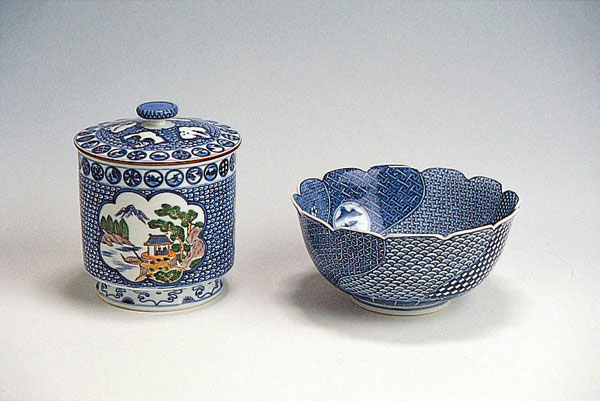
- Ceramic
- Aichi
Seto-sometsuke ware Seto sometsuke yaki
Asbolite indigo blue makes a beautiful contrast
with gentle transparent white unglazed pottery
Description
What is Seto-sometsuke ware ?
Seto Sometsuke ware (called Seto Sometsuke yaki in Japanese) is ceramic ware produced near the cities of Seto and Owariasahi in Aichi prefecture. The term sometsuke is normally used when designs are painted on porcelain with an indigo blue pigment, but for this craft, it also includes painting on ceramics. Seto Sometsuke ware is a white bisque fired pottery and has realistic and delicate designs drawn with indigo colored pigment. The area around Seto is famous for producing potter’s clay like feldspar from Mount Sanage, Honyama-kibushi clay, and Honyama-gairome clay, which are used as the raw materials for the white base. The scenery and nature of Seto are drawn onto the white base using asbolite which usually develops an indigo color.
History
Seto Sometsuke ware dates back to the early 19th century during the Edo period when a potter from Seto named Tamikichi KATO learned how to manufacture porcelain in Kyushu and brought the technology back home. Porcelain painters then learned the art of Chinese-style painting from various artists that visited Seto, and developed the techniques for ceramics painting. It is said that production and decoration techniques were established in the middle of the 19th century. The painting techniques, which depict the scenery and nature of Seto, were highly praised at the World Expos held in Paris and Vienna and influenced the Art Nouveau movement in Europe. As the Meiji period (1868-1912) began, Seto Sometsuke ware production became more prosperous. In addition to tableware and stacked food boxes, large products such as tables, hanging lanterns, and flower vases were produced, which steadily continues today.
General Production Process
- 1.Preparing the potter’s clay The raw materials of Seto-Sometsuke ware include Honyama-kibushi clay, which has a slight viscosity, Honyama-gairome clay, and translucent sanage feldspar all produced in Seto. A number of raw materials are blended to produce a soft potter's clay.
- 2. Formation of unglazed pottery
Potter’s clay is formed using a potters wheel, closed die forging, where unglazed pottery is pressed against a mold, or formed by hand. After forming, the thickness of the unglazed pottery is adjusted by planing, and the surface is cleaned by wiping with a wet cloth or sponge. Patterns may also be applied at this time. Traditional techniques include kakka, where patterns are engraved with a plane or spatula, and inka, where patterns are applied by pressing stamps.
- 3. Drying and bisque firing
The formed pottery is dried and bisque fired at a low temperature of around 850°C (1562°F).
- 4. Underglaze decoration
A decoration is applied to the pottery before enamel glazing. For this craft, sometsuke techniques are used for the underglaze decoration. Sometsuke involves directly painting pictures onto the unglazed pottery using a paint called asbolite, which is produced from oxidized cobalt pigment. There are various types of painting such as line drawing where outlines are drawn with thin lines, dami or gradation inside the line drawings, and tsuketate, where pictures are freely painted without outlines.
- 5. Glazing
After the sometsuke decoration, enamel is applied to the unglazed pottery through soaking, dipping, or with a paintbrush. The enamel mainly used is lime glaze, which has transparency and glossiness. Other types of enamel used are celadon porcelain glaze, azure glaze, and oak ash glaze.
- 6. Firing
After drying the glazed pottery, the next process is glaze firing. This craft has a unique process called nerashi, that is done in the final part of firing. Nerashi involves maintaining the kiln temperature at around 1250°C (about 2282°F) for a fixed period of time to mature the enamel.
- 7. Completion
Once the firing, including the nerashi process, is completed, the porcelain is finished and removed from the kiln. If more decorations are to be painted, it is done at this stage after the glaze firing. Gold, silver and other new coloring is applied using the painting techniques that were used for the underglaze decoration like line drawing and dami, and the pieces are fired at a low temperature of 700 to 800°C (about 1292 to 1472°F).
Where to Buy & More Information
Seto-Sometsuke Crafts Center
-
Address
-
Tel.+81-561-89-6001
-
ClosedTuesdays (open on Tuesday if it is a holiday and closed on Wednesday), December 28 to January 4
-
Business Hours10am to 5pm
-
Website
See more Ceramic
- Imari ware/Arita ware
- Hasami ware
- Kutani ware
- Mashiko ware
- Shigaraki ware
- Bizen ware
- Hagi ware
- Koishiwara ware
- Mino ware
- Tobe ware
- Tokoname ware
- Karatsu ware
- Kasama ware
- Satsuma ware
- Iga ware
- Mikawachi ware
- Agano ware
- Otani ware
- Obori-soma ware
- Tsuboya ware
- Aizu-hongo ware
- Shodai ware
- Echizen ware
- Akazu ware
- Tamba-tachikui ware
- Yokkaichi-banko ware
- Izushi ware
- Kyo ware/Kiyomizu ware
- Iwami ware
- Amakusa ceramics
- Seto-sometsuke ware
- Sanshu Onigawara Crafts
See items made in Aichi
- Tokoname ware
- Akazu ware
- Toyohashi brushes
- Nagoya textiles
- Nagoya Buddhist altar
- Owari Cloisonné
- Arimatsu tie-dyeing
- Mikawa Buddhist altar
- Seto-sometsuke ware
- Nagoya kimono-dyeing
- Nagoya traditional paulownia chest
- Okazaki stonemasonry
- Nagoya Sekku Kazari
- Owari Buddhist altar equipment
- Sanshu Onigawara Crafts































































































































































































































































































